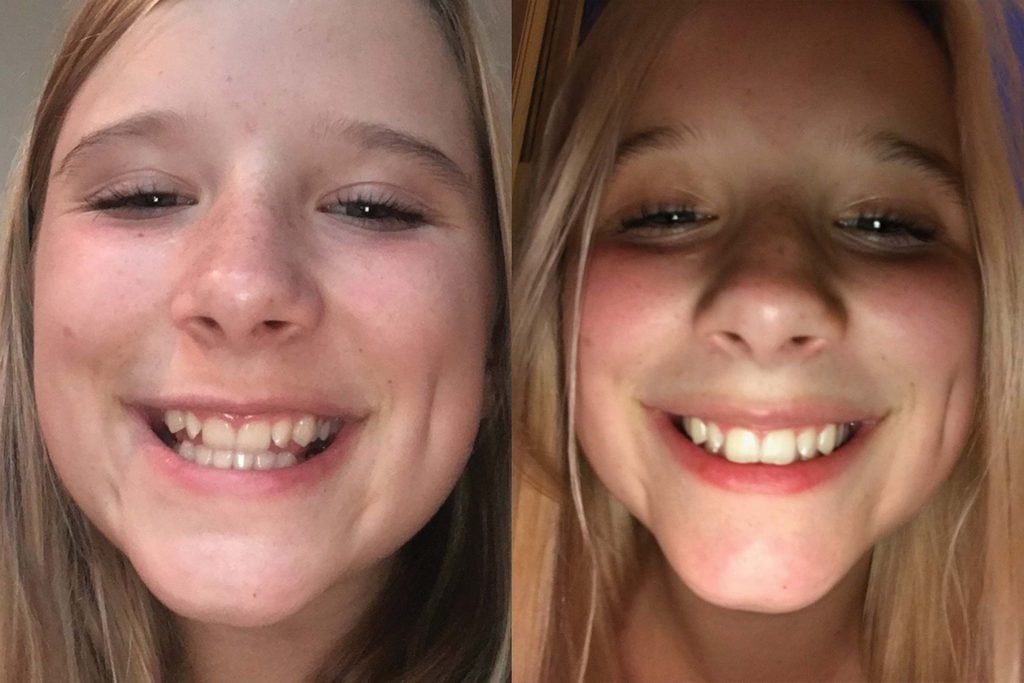How I Straightened My Teeth Without Braces
Updated: Oct. 09, 2019

I got a brand new smile in only eight months for less than $2,000.
I was so insecure about my teeth that I had stopped smiling—even in the mirror. The way my canines poked forward made me look like a rodent. When a kid at my school called me a mole rat, I knew I had to make a change. But all my friends were finally getting their braces off, so I didn’t want to first be getting a mouth full of metal. That’s when I learned about SmileDirectClub.
SmileDirectClub uses clear, nearly invisible aligners (like retainers) that gently adjust your teeth over time. It’s a lot like Invisalign, which you may have heard of, but it’s up to 60 percent cheaper: $1,895 for a one-time payment (or $2,290 paid in monthly installments) vs. $3,400 to $7,100 for Invisalign and $3,000 to $7,500 for traditional braces. If your insurance covers a portion of the plan and you’re able to take advantage of flexible spending, you could end up paying as little as $750 total. SmileDirectClub also doesn’t require any attachments to the teeth (as both braces and Invisalign do), and you’ll never have to see a dentist or orthodontist—not even once.
To kick off the teeth-straightening with SmileDirectClub, you can either use an at-home impression kit or visit one of the company’s 95 “SmileShops” around the country to have a 3D scan made of your mouth. It was actually really cool to have this done. As a technician moved a scanning device around my teeth, I could see an image of the aligners taking shape on a screen. There was zero discomfort and it was over in 10 minutes. Those scans went to an orthodontist licensed in my state who determined that I was a good candidate for aligners—the system isn’t designed for extreme dental makeovers—and then developed a treatment plan just for me. A month later, I received a box with 17 sets of aligners, numbered in order, to be worn for two weeks at a time. (Plus a bonus whitening kit—score! Find out more about dentist-recommended products to whiten your teeth.)
From there it got a little harder. Wearing the aligners—or “smilers,” as the company calls them—was pretty painful, especially for the first 24 hours of each new set. And a few times my gums got irritated and I got tiny cuts on the tip of my tongue. Obviously, I had to remove the aligners to eat—and nearly lost them in napkins more than a few times. I never forgot to change sets, though, because the company sends reminder texts when it’s time to switch.
I actually looked forward to these texts because it meant I was another step closer to a confident smile. I was also careful to follow these golden rules for white, healthy teeth.
While I had a virtually problem-free experience, many dental experts warn of the potential pitfalls of straightening your teeth this way. “It’s very important to have a comprehensive consult with a skilled dentist to assess your oral health beforehand, including X-rays to determine bone and gum health and check for cavities,” says Jennifer Jablow, DDS, a cosmetic dentist in New York City. “If the mouth isn’t healthy, moving the teeth can actually make the situation worse.” SmileDirectClub has also been the target of a lawsuit in Georgia over whether its use of digital scanners constitutes “the practice of dentistry,” and the American Dental Association has filed an official complaint with the FDA over what they consider the risks of using SmileDirectClub‘s products.
Eight months later (a little longer than the average six-month treatment) my teeth are visibly straighter. They’re not Hollywood perfect, but for the first time in years, I’m happy to smile with my mouth open. Next, check out the things your orthodontist won’t tell you—but you’ll want to know.
